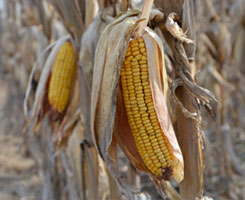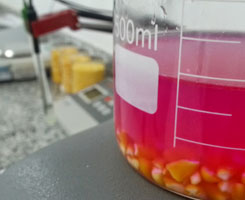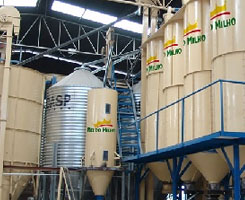
No one knows
more about corn
than us!
Industrial Responsibility
Quality and production controlAgriculture and cultivation
Discover the origin of our raw materialCorn crop suffers from lack of rain in the Southeast
Sufficing not have cluttered the planting of summer grain harvest in the current 2014/15 cycle, the heat and lack of rain also hampered the development of these crops in part of the country - and the corn has not escaped the climate scam.

Estimates are still taking shape, but there is already a degree of consensus among farmers and market experts that important producing regions of cereal will have some level of productivity loss, especially in the Southeast.
"Some say 10%, 20% and up to 40% reduction in corn yield, compared to the initial expectation. It's a little early to set this number, but yes there will be a negative impact", said Ana Luiza Lodi, analyst FCStone. The greatest tension, he says, is in Minas Gerais, main corn producing state in the first season - the summer harvest.
After the drought in October 2014, grain sowing period, miners farmers have suffered from a new drought in early January. "We pretty much the first 20 days of the month without rain, which caused concern because it reached some crops in very vulnerable stage of flowering and early fruiting," Wilson says José Rosa, Company of state technical cultures coordinator Technical Assistance and Extension Rural Minas Gerais (Emater / MG).
According to Rose, the rains returned in recent days, but not a generalized way. The Emater / MG is recalculating the corn yield projection, and the possibility of the State approaches of 6000 kilograms per hectare, as predicted Conab, seems small. "We will not get to that level, but I think we would be above 5230 pounds in the previous harvest. Everything still depends on rainfall in the coming weeks, although we have little hope of normalization," he says.
In Gotthard, municipality of Alto Paranaíba region and one of the most important producers of miners corn, the prospect of harvest has been reduced by 17%. "With the Indian summer of January, we expect decreased from 7200 pounds to about 6000 per hectare," says Marco Antonio Carvalho da Costa, agronomist Emater / MG.
Ana Luiza, FCStone, the proportion of fall will become clearer from the end of February, when mines start harvest. But the extent of any engagement with the area of ??the corn crop extends beyond the state. "There are problems from northern Paraná, passing through São Paulo, south of Minas Gerais, Minas Triangle, High Paranaíba, to Goiás" lists Anderson Galvao, CEO of Céleres consulting.
In the south, on the contrary, more celebratory reasons. "Corn got away here, we are very optimistic," says Paul of Tarsus Silva, president of the rural union of Passo Fundo (RS). The state is deputy leader in the summer maize production. According to Silva, there was no water or electricity for the plants, and the result is a productivity projection between 9500 and 10 000 kg per hectare in the region - last year, with more limited rainfall, not reached 8000 pounds . "We are 30% to 40% above average rainfall. Every two or three days, gives a mist."
Prices do not have excited the gauchos. Quotes are between £ 22 and £ 23 per bag in Passo Fundo, but farmers expect from R $ 28 to R $ 30. "Buyers also have" shown the face ', "says Silva. The harvest in the state has been completed in 17% of the area in time to the historical average.
In Paraná, the field corn withdrawal jobs reach 6% of the area, slightly early from a year ago. "We even had some pockets where it rained less, but not stopped raining," says Francisco Simioni, head of the Department of State for Rural Economy (Deral). Favored by the weather, productivity forecast is 8600 pounds, 5% above the previous harvest.
Galvao, the Céleres, points out that a drop of 5% to 10% in the first corn crop could be offset by higher production in the second season (the off-season), but there is another delicate situation. "We expect a second crop with lower technology and late planting. Thus, a small break in the summer can have a greater impact," he predicts. In recent years, the production of maize in the country has focused on off-season: In 2013/14, 60% of total production came from this winter harvest.
The supply reduction would come at a time of strong demand, especially for animal feed. "The low maize prices in 2014 encouraged producers of chickens, pigs and cattle feedlots until, in Brazil and in the world. If we go to a situation of greater tight supply, there could be an upward influence on prices," concludes Galvão.
Source: Mariana Caetano, Economic Value
 PopiMAX
PopiMAX
 PopMAX
PopMAX
 CornMAX
CornMAX
 CornMAX White
CornMAX White
 SnackMAX 300
SnackMAX 300
 SnackMAX 200
SnackMAX 200
 SnackMAX 1515
SnackMAX 1515
 BeerMAX
BeerMAX
 SemMAX
SemMAX
 FecoMAX 1
FecoMAX 1
 FecoMAX 2
FecoMAX 2
 CremMAX
CremMAX
 FiberMAX
FiberMAX
 GerMAX
GerMAX


































